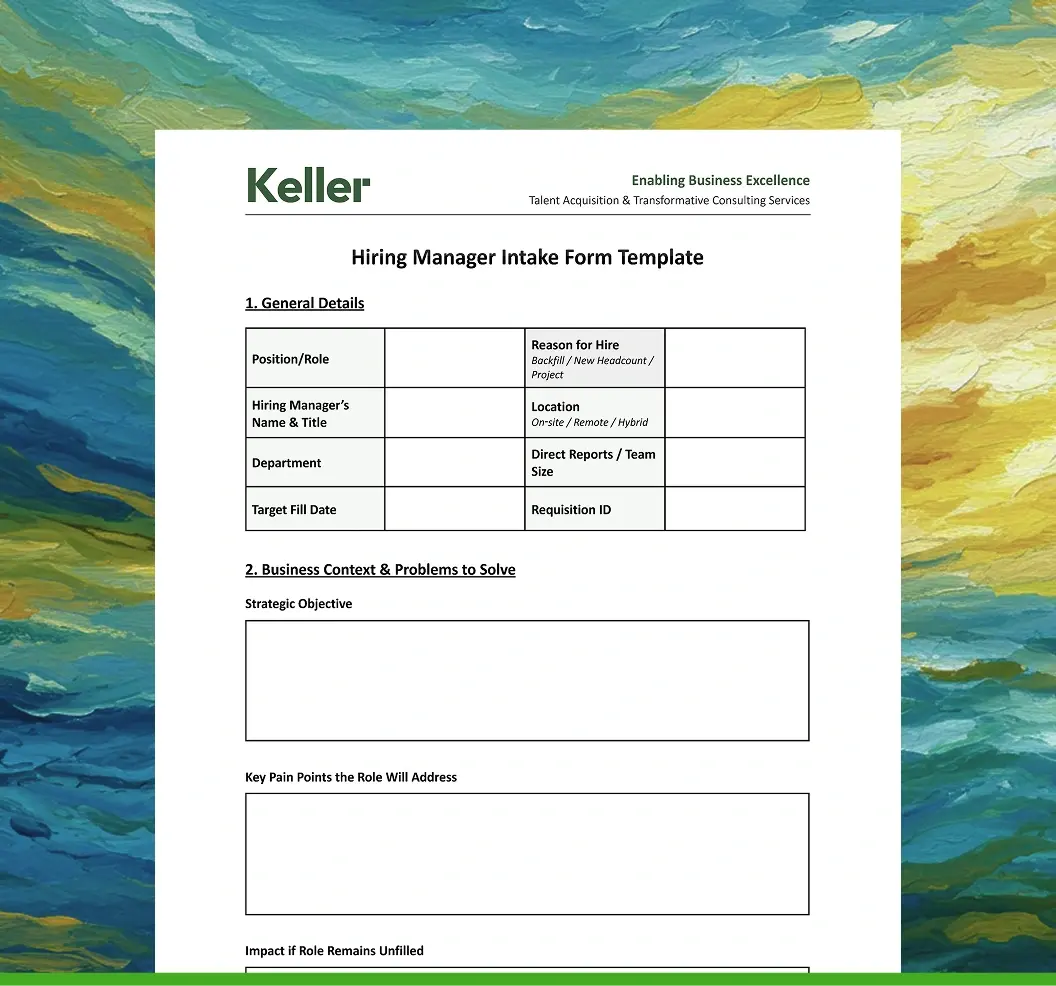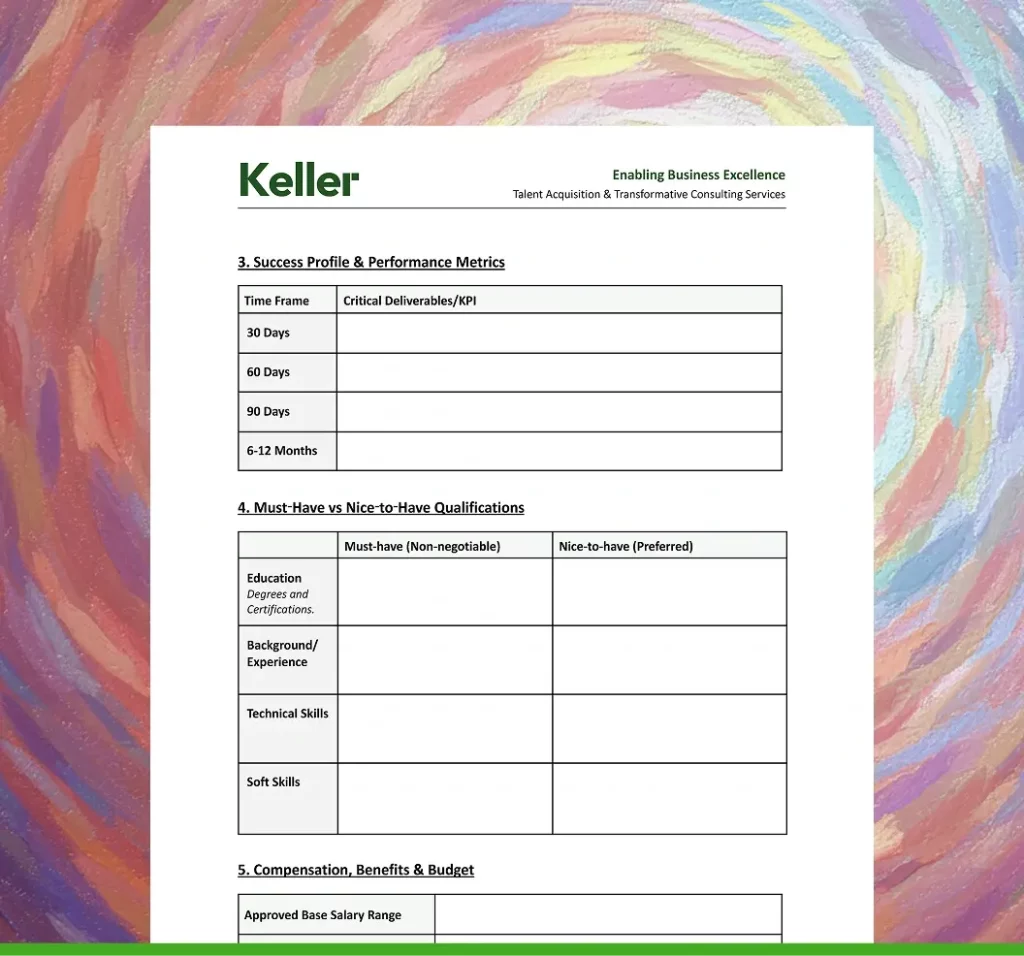Hiring Manager Intake Form: Your Blueprint for Faster, Smarter Hiring
TABLE OF CONTENTS
Download Template
Recruiting leaders agree on one point: speed and clarity decide who lands top talent. When those qualities are missing, well‑known brands can watch preferred candidates accept offers elsewhere. A well‑built hiring manager intake form restores order.
By turning an early conversation into a structured record, what many talent teams now call a recruitment intake form, recruiters and hiring managers create a single reference that guides each step of the recruiting process, from first brainstorming sessions to signed offers. The pages that follow explain why the document matters, what belongs in it, and how executives can create an accurate form template that lasts.
Key Details

Think of the intake form as a flight plan for each job opening. It keeps everyone, recruiters, hiring managers, and leaders, pointed in the same direction.
Key details the form captures
- Business goals
- Must‑have skills vs. nice‑to‑haves
- Interview logistics
- Salary and sign‑off steps
What Is a Hiring Manager Intake Form?
A hiring manager intake form is a digital questionnaire that captures every detail the talent team needs to fill a job opening. It begins with the basic information, department, cost center, and reporting line then moves into richer data. Unlike a public job description, which promotes duties to job candidates, the intake document remains private and digs deeper. It spells out the business goals behind the hire, the “must haves” and nice‑to‑haves, and the exact job requirements that let interviewers quickly assess candidates.

To help managers prepare, many templates include a short set of example questions the recruiter will ask during kickoff. The form also confirms the salary range, the job title, the interview plan, and the people who must sign off on a job offer. Because it never leaves the company, it can include sensitive background information such as pay bands, succession notes, or a preferred career path for the role. When the recruiting intake form is finished, recruiters work with clear instructions instead of guesswork, and hiring managers feel confident their needs have been heard.
Why an Intake Meeting Puts the Hiring Team on the Same Page
The intake document comes to life in an intake meeting. During this short session, the recruiter, the hiring manager, and a key team member walk through each field line by line. In thirty to forty‑five minutes they surface the hiring manager’s expectations, confirm the interview timeline, and leave the room on the same page about how the hiring process should unfold. Gartner data shows that vacancies linger twenty‑two percent longer when teams skip this kickoff.
Companies also report a seventeen‑percent drop in early turnover when the hiring team aligns before sourcing begins. After the meeting, everyone knows when interviews start, which internal candidates deserve a first call, and which evaluation rules will keep bias low while helping them save time. Because those rules cover both résumé reviews and interviewing candidates, the process feels consistent to every applicant and every panelist.
Core Elements Every Intake Form Should Capture
A solid recruiting intake form template arranges information in a steady order so people can scan and act fast. First comes the position title, the organizational hierarchy, and a short summary of core duties. Next appears the approved salary range plus equity or bonus notes, followed by the split between required skills and nice extras, including technical skills, soft skills, and relevant industry experience.
The template ensures nothing critical falls through the cracks by asking whether certain sourcing criteria apply, whether specific internal candidates deserve an early review, and which panel members will conduct interviews. It also stores a target start date, early milestones, and space for additional comments that might guide a smooth recruitment strategy. By standardizing these fields, the form template removes duplicate emails and protects critical data from getting lost.
Essential Fields For Every Intake Form
- Job title and corporate hierarchy
- Five‑line job description focused on outcomes
- Approved salaries plus bonus or equity notes
- “Must haves” and “nice‑to‑haves” for skills, licenses, and tools
- Preferred talent pools, including internal candidates ready to step up
- Interview panel names and decision roles
- Target start date and early project milestones
- Open space for additional comments from the manager
Business Context & Success Metrics
Every requisition exists for a reason, and the intake form should explain it in plain language. Tying the hire to revenue goals, customer growth, or compliance gives human resources a compass and keeps the recruitment process focused. Two or three performance measures make success concrete. One example could be a promise that the new leader will help the team hire twenty percent more engineers within two quarters, a clear sign of a successful recruitment process. Setting checkpoints at thirty, sixty, and ninety days lets executives observe progress early instead of finding problems after the fact.
Candidate Profile Details
Defining the ideal candidate takes more than listing certificates. The document blends credentials with traits that fit the company culture. A short ideal candidate profile might cite three core technologies, two collaboration habits, and five years of industry experience. The template also leaves room to describe how the hire will help the team reach stretch goals, with a statement on what ideal candidates achieve. By encouraging openness to potential candidates who satisfy most, though not all, requirements, the intake form widens the pool without lowering standards.
Compensation & Approvals
Money disputes derail many searches, so the form places the salary range in writing on day one. It lists every person who must approve exceptions and clarifies how relocation, equity, or remote‑work stipends will be handled as part of total employee information. Aligning early on pay and perks helps recruiters present offers that land the right candidate on the first attempt.
Best Practices for Using an Intake Form
A productive recruitment intake meeting feels like a working session. Before the call, the recruiter gathers salary data, studies competitor jobs, and drafts two sourcing paths. During the meeting everyone agrees to set expectations about response times—for example, twenty‑four hours for résumé feedback and seventy‑two hours for panel scores—and walks together through the planned screening process.
Afterward, the recruiter emails a link to the final intake form template inside the applicant‑tracking system and schedules a two‑week review. These habits turn the intake form into a living guide instead of digital dust.
Follow these steps and the document becomes a daily driver, not shelf décor.
Before the meeting
- Pull fresh market pay data and competitor hiring trends.
- Draft two sourcing paths and review sourcing criteria with the manager.
During the meeting
- Agree on response times—24 hours for résumé feedback, 72 hours for panel scores.
- Walk through the screening process so every interviewer uses the same rubric.
After the meeting
- Send the final form link (from your ATS) within one business day.
- Book a two‑week checkpoint to check funnel health.
Integrating the Form Into Your Recruiting Process
Modern tools place the form at the center of talent acquisition. Housing it in the Applicant Tracking System (ATS) means recruiters never search for attachments, while links inside Slack or Microsoft Teams provide easy access for busy leaders. Automated workflows copy fields from the form template into postings and scorecards without extra typing, trimming hours from the overall process. Some firms even connect the template to budgeting software so finance approves spending the moment the form hits their queue.
Managing Employee Information & Feedback Loops
Top employers link the intake form with their HRIS to automatically manage employee information once a candidate accepts. At that point, the system also launches welcome tasks so the new employee receives equipment on day one. After each interview, panel members add timely employee feedback about skills, culture fit, and desired qualifications.
Recruiting operations teams log every adjustment to the interview timeline, and analysts review patterns such as repeated delays or off‑target questions. Over a year this data shows which interviewers find the best candidates fastest and where revisions to the form template will sharpen focus, leading to an even smoother experience for the next new employee.
Measuring Success & Refining the Intake Form
Data converts good habits into great ones. First track days from intake to offer and count recruiter hours per requisition to verify the hiring process stays lean. Next, compare interviews completed to offers accepted, then check performance scores six months in. Funnel health matters too: note how many finalists arose from the first shortlist and how often leaders needed a second or third slate to secure the perfect candidate.
Watch for red flags like repeated pay disputes or confusion about job requirements. Update the recruiting intake form every quarter, adding clearer prompts and retiring unused fields. Regular edits keep the form sharp while each improvement helps locate top talent faster.
Numbers turn good practice into great practice.
- Time savings: Track days from intake to offer and recruiter hours per req.
- Quality: Measure offer acceptance rate and manager satisfaction 90 days in.
- Funnel health: Count how often the shortlist includes the right candidate first time.
- Red flags: Repeated pay declines, skill mismatches, or roles re‑posted more than once.
From Quick Wins to Lasting Impact: Turning the Intake Form into a Strategic Engine
Disciplined use of a precise hiring manager intake form pays dividends beyond quick wins. The same data guides onboarding for new hires shapes KPIs for the new position, and safeguards brand reputation when external candidates share positive stories. Executives can strengthen succession plans by demanding that every requisition begins with a refreshed recruiting intake form template and a thirty‑minute kick-off call.
Monthly dashboards should highlight cycle time, acceptance rate, and early retention so leaders see progress at a glance. Funding half‑day workshops will help recruiters and managers create cleaner templates, refine other tools, and expand skills that let them conduct interviews with confidence. When senior leadership champions a data‑rich intake form, the company gains alignment, trims waste, and elevates hiring quality—advantages any board can endorse with pride.










